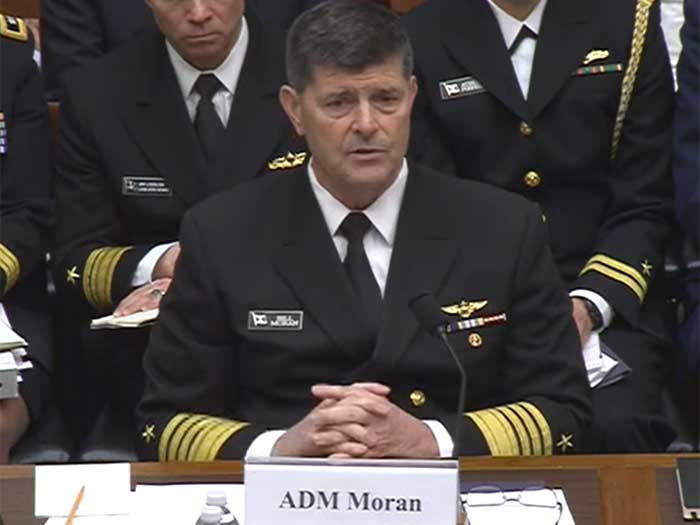
VCNO: Navy readiness at lowest level in years
Written by Nick Blenkey
"We're flat out of money," Vice Chief of Naval Operations Admiral William F. Moran said in verbal testimony
FEBRUARY 8, 2017 — “It has become clear to me that the Navy’s overall readiness has reached its lowest level in many years,” Vice Chief of Naval Operations Admiral William F. Moran told a hearing of the House Armed Services Committee on The State of the Military, yesterday.
In his prepared testimony, Admiral Moran identified three main drivers of the Navy’s readiness problems: 1) persistent, high operational demand for naval forces; 2) funding reductions; and 3) consistent uncertainty about when reduced budgets will be approved.
“The operational demand for our Navy continues to be high, while the fleet has gotten smaller. Between 2001 and 2015, the Navy was able to keep an average of 100 ships at sea each day, despite a 14 percent decrease in the size of the battle force. The Navy is smaller today than it has been in the last 99 years. Maintaining these deployment levels as ships have been retired has taken a significant toll on our Sailors and their families, as well as on our equipment.
“The second factor degrading Navy readiness is the result of several years of constrained funding levels for our major readiness accounts, largely due to fiscal pressures imposed by the Budget Control Act of 2011. Although the Bipartisan Budget Act of 2015 provided temporary relief, in FY 2017 the Navy budget was $5 billion lower than in FY 2016. This major reduction drove very hard choices, including the difficult decision to reduce readiness accounts by over $2 billion this year.
“The third primary driver of reduced readiness is the inefficiency imposed by the uncertainty around when budgets will actually be approved. The inability to adjust funding levels as planned, or to commit to longer-term contracts, creates additional work and drives up costs. This results in even less capability for any given dollar we invest, and represents yet another tax on our readiness. We are paying more money and spending more time to maintain a less capable Navy.”
Admiral Moran said that deferred maintenance has led to equipment failures, and to larger-than-projected work packages for shipyards and aviation depots.
“This has forced us to remove ships and aircraft from service for extended periods, which in turn increases the tempo for the rest of the fleet, which causes the fleets to utilize their ships and airframes at higher-than-projected rates, which increases the maintenance work, which adds to the backlogs, and so on,” he said.
“Reversing this vicious cycle and restoring the short-term readiness of the fleet will require sufficient and predictable funding,” he said. “This funding would allow our pilots to fly the hours they need to remain proficient, and ensure that we can conduct the required maintenance on our ships. It would also enable the Navy to restore stocks of necessary parts, getting more ships to sea and better preparing them to stay deployed as required.”
Watch the video of the full hearing to learn more on how budget restraints are impacting both naval shipyards and private ship repair yards.





Leave a Reply
You must be logged in to post a comment.